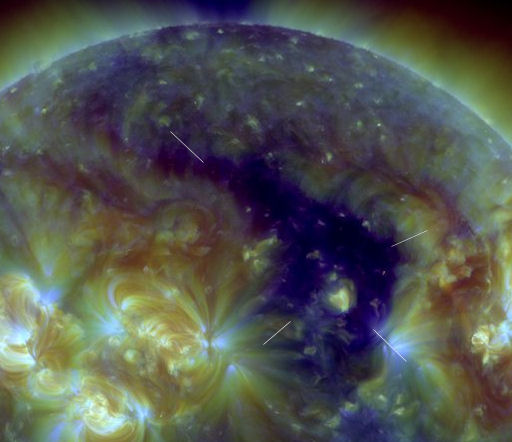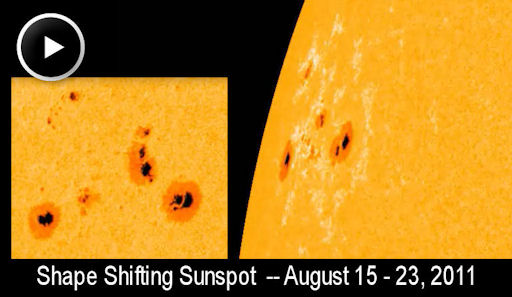Metallic photos of the sun by renowned photographer Greg Piepol bring together the best of art and science. Buy one or a whole set. They make a stellar gift. | | |
SUNSPOT BREAKTHROUGH: A new breakthrough in sunspot detection could provide days of extra early warning for strong solar storms. Get the full story from Science@NASA.
CORONAL HOLE: A yawning dark hole in the sun's atmosphere is spewing solar wind toward Earth. NASA's Solar Dynamics Observatory photographed the opening during the early hours of Aug. 26th:

Solar wind flowing from this coronal hole is expected to arrive on Aug. 28-29, possibly causing geomagnetic activity around the poles. Arctic sky watchers should be alert for auroras on those dates. As summer winds down, the midnight sun is waning for improved visibility of Northern Lights. Aurora alerts: text, voice.
more images: from Brandon Lovett of Fairbanks, Alaska; from Francis Anderson of Yellowknife, Northwest Territories Canada; from Frank Olsen of Stø, Norway; from Bjarki Mikkelsen of Jokkmokk Porjus, Lapland, Sweden; from Sean M. Scully of Akureyri, Iceland;
August 2011 Aurora Gallery
[previous Augusts: 2010, 2009, 2008, 2007, 2006, 2005, 2004, 2003, 2002]
SUNSPOT MOVIE: Sunspots are planet-sized islands of magnetism floating in a fiery sea of solar plasma. Unlike the hard-rocky islands of Earth, however, the "firmament" of sunspots is in a constant state of flux. Boiling motions in the underlying plasma cause sunspot magnetic fields to move and shift, so that the active regions change shape on a daily basis. This movie from the Solar Dynamics Observatory shows the process at work in sunspot AR1271:

Readers, you can witness these changes with your own eyes using a safe sunspot telescope. Several new active regions are popping up across the solar disk, so there should be plenty of targets for sight-seeing this weekend.
more images: from Francois Rouviere of Mougins, France; from John Chumack of Dayton, Ohio; from Steve Wainwright of Gower S.Wales UK; from Pawel Warchal of Cracow, Poland
2011 Noctilucent Cloud Gallery
[previous years: 2003, 2004, 2005, 2006, 2007, 2008, 2009]
Potentially Hazardous Asteroids (
PHAs) are space rocks larger than approximately 100m that can come closer to Earth than 0.05 AU. None of the known PHAs is on a collision course with our planet, although astronomers are finding
new ones all the time.
On August 26, 2011 there were 1241 potentially hazardous asteroids.
Notes: LD means "Lunar Distance." 1 LD = 384,401 km, the distance between Earth and the Moon. 1 LD also equals 0.00256 AU. MAG is the visual magnitude of the asteroid on the date of closest approach. | | The official U.S. government space weather bureau |
| | The first place to look for information about sundogs, pillars, rainbows and related phenomena. |
| | Researchers call it a "Hubble for the sun." SDO is the most advanced solar observatory ever. |
| | 3D views of the sun from NASA's Solar and Terrestrial Relations Observatory |
| | Realtime and archival images of the Sun from SOHO. |
| | from the NOAA Space Environment Center |
| | the underlying science of space weather |
| | for out-of-this-world printing and graphics |

